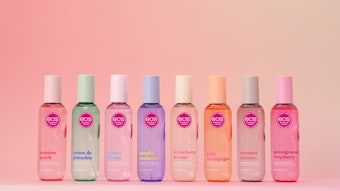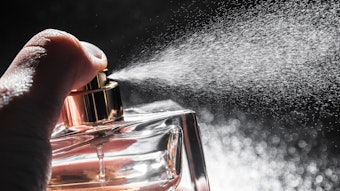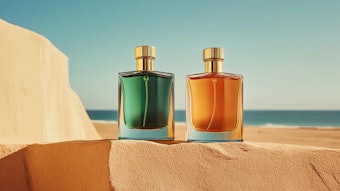- As one result of the global recession, fragrances strive to help lift moods with scents that are comforting and warm, as well as fun and playful. They also contain less of a sharpness and feature a softer edge.
- The need remains for a 360-degree marketing approach, considering the color of the formulation and the product packaging when developing a new fragrance product.
- Customization is in, with people having the opportunity to create their own scents and seek out fragrances developed to mirror specific body compositions.
- Brand DNA continues to be a guiding factor in the development of new fragrance products.
Fragrance trends can be hard to nail down, as fragrance can be such a subjective subject. “Above all, people want something that smells good. People respond to what they associate the fragrance with, and not necessarily the exact scent of something at all,” says Jill Costa, chief perfumer with Bell Flavors & Fragrances. However, there are trends that do stand out in both fine fragrance and fragrance for body and cosmetic products.
Major Scent Trends
“The one trend we do see a lot of right now is still the sweet, gourmand, fruity fragrances,” says Costa. “It has been going on for awhile, but there’s a lot more of it—really pretty floral-type notes, or a chypre note that isn’t at all floral but based on something more woody or another type of character. There are also some throwback notes in the scents, but by and large, things are very ‘what they are,’ whether they are very marine, very floral, very woody ... it’s still pretty, but it also makes a strong statement.”
Kellie Como, vice president of fragrance and product development, Inter Parfums Inc., explains the trends she’s seeing. “There has been a chypre trend happening in the past six years, but now I think we’re seeing more of a softening effect in fragrances, scents that are rounder and more comfort-driven,” she says.
Wendy Patel, senior evaluator with Firmenich, comments, “We see a lot of creamy vanilla and oriental type fragrances with fresh fruity top notes. The fruit notes help offer an easy point of entry to fragrances, and the vanilla is offering some warmth and comfort. Also, woody scents are growing, which is something we’d seen in Europe over the past few years that is finally coming more stateside.”
Expanding on the origins of some of the currently popular fragrances, Como notes, “For women, there seems to be more femininity coming back. It’s going back to the ultra feminine fragrances of the ’30s and ’40s, but making them more modern and sleek, and incorporating natural elements.” For men, Como notes a softer edge, as well. “What has happened recently with men’s fragrances is that they’ve started to take a little bit more of a move toward floralcy,” she says. “We’ve come out of the hard woody notes, the darkness notes. Now it’s a kind of fresh darkness, with leather always being a popular note, as well as fougere. The scents are still big, but they’re just a bit softer.”
Fragrances with a softer edge aren’t the only driving force of note, though. “We’re also seeing more fragrances that are fresh and playful and have a sense of fun,” Patel says, and Firmenich vice president of creative marketing Debra Butler adds, “The notes of freshness and escapism are in both men’s and women’s fragrances.”
Finding Inspiration
Of the softer fine fragrances the beauty industry has seen of late, Como explains, “Given what we’ve gone through with the economy, fragrance consumers may want something that’s easy and comforting. We’ve seen lots of fragrances that are a little more disruptive in signature, and it is moving toward soft simplicity, however you want to describe that—it can be called a light oriental or round floralcy approach. There’s less heaviness and more of a natural feeling, using nature-inspired ingredients.”
Butler agrees, noting, “People are reverting to scents that are comforting, almost nostalgic but with a modern structure, and that’s part of where the woody trend comes from, I think; a sense of stability and rootedness, both literally and metaphorically.”
Como also notes that mass market fragrances are developed to appeal to a large audience. “Most times, a fragrance sold in a department store needs to be developed to sell well, so the scents need to be a little more broad in appeal than what you could develop for a niche specialty market,” she explains. However, Como says this doesn’t mean more largely marketed fine fragrances don’t take cues from the specialty side. “Many commercial fragrances are a nod to the niche fragrances and taking steps to move back to this more traditional, pure fragrance direction again,” she says. Patel notes that inspiration for a new fragrance can be drawn from nearly anywhere, including restaurant cocktails and light bulbs. “It could even be something as abstract as a quote, with the perfumer trying to translate the eloquence of how something was said into fragrance,” she says.
Additionally, more and more, fine fragrances are being adapted into body products such as lotions, shower gels and cosmetic products. However, these products don’t always necessarily adhere to the same scent dynamics. “Its not a direct translation of the actual note, but more of a translation of the idea,” explains Costa.
“People who are using body products for scent use fragrance with a different mindset,” Como says. “There has been a preference for cleaner wearability.” And Butler says, “You can see the sensorial experience there, and now the scents are aligned with perfumers creating the scent parallel to how they would a fragrance for the fine fragrance industry. Sometimes, they even set the trends, like when vanilla emerged as such a hot ingredient.”
Marketing Fragrance
When creating a significant presence for a new scent, whether it is in a body product or as a fine fragrance, there is a distinct need for marketing support. “People want to know the real story,” says Butler, and Patel agrees, noting that, “Creating the scent story is very important.”
Como encourages a hands-on scent shopping experience to help convey that message to consumers as forthrightly as possible. “One of the most important things in the fragrance sales process is having a sales associate there to knowledgeably discuss the product,” she says. “Self service in fragrance makes it really hard for one scent to stand out among a display of 25 other products, and packaging and great advertising visuals can really help with that, but there’s nothing like having a person there to speak to the product and give it a human touch.”
“We would like to talk more to consumers to help educate them more about what they’re actually smelling,” says Patel. “That way, they can identify a little more with [the fragrance] as opposed to just having to accept the brand’s defined concept and message.”
Seeking out the best ways to talk to potential fragrance consumers can be challenging, though. Firmenich recently collaborated with The NPD Group on research of fragrance users, finding distinct differences between those deemed as heavy users and those who are non-heavy users. “The non-heavy users still love scent, but they use it in different ways,” says Butler. “We’ve also learned the consumers are very different—we don’t have just one target consumer, a women age 18–35. All these women are different—different life stages, different ethnicities, different backgrounds—and we want to speak to them in a way that allows them to participate. We learn to listen to find out what is relevant to them. What we’re seeing is that we need multiple approaches, and we need to go to the consumers rather than waiting for them to come to us. We want to create an experience they want to participate in and make their own.”
Additionally, all the elements of a fragrance need to support the scent itself. “If a client is looking for a scent that conveys green tea and cucumber, they are not only working with the fragrance for that, but also the color of the formulation and the packaging for the product that is very well-tailored to speak to those things,” Costa says, demonstrating the need for a 360-degree marketing approach when developing a new fragrance product.
New Fragrances for New Consumers
As always, keeping the brand in mind when developing new fragrances is always necessary in order to maintain a connection of the new products to the brand’s overall strategy and picture. “Right now, we are looking to create a signature fragrance that builds on the brand, which is what we’ve normally done,” Como says. She also acknowledges the importance of brand when developing new scents. “Each brand has its own personality, and that really helps guide where you can take it,” she notes. “You have to be true to your brand. There’s a distinctly developed DNA for each brand that helps it stand out and connect with its customers.”
Making that point of connection wherever possible is the key with consumers, whether it is through popular notes in scent, the medium through which the product is marketed or how the fragrance can be customized to meet their needs.










